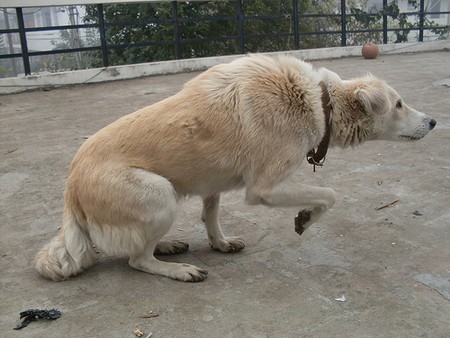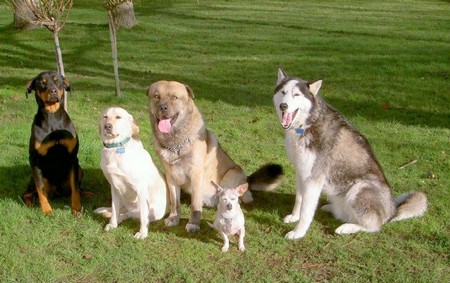Dogs employ a vast range of facial expressions, vocal sounds and body postures in order to communicate. Many owners talk to their dogs, and sometimes the two parties appear to understand each other. Dogs possess a large universal vocabulary, and some people have attempted to translate what they are saying.
Unhappy or ill
This body posture indicates a depressed and unhappy dog. Such a stance could be due to a stressful atmosphere (a perceived threat from another dog, a disruptive household or physical or mental abuse) or because he is experiencing physical discomfort due to illness.

Calm, content and curious
The pricked ears and kind, interested expression indicates a calm, content and curious dog. This breed, the German Shepherd Dog, was developed in its native country to herd sheep, so its natural instincts are to guard and be watchful, and the expression here shows the breed at its best – alert, generous and intelligent.
Fear-aggression
This is the face of fear and defensive aggression. The ears are back and the mouth is wide with worry. However, the lips are drawn up slightly to expose the teeth, the head is up ready to bite and the eyes are fixed on the antagonist so that further aggressive action can be taken if necessary. This face is accompanied by a series of explosive barks designed to make the aggressor move away.
Frightened
A frightened dog will pull away from whatever it is that has worried him: the tail and ears are tucked well out of harm’s way in case of attack, eyes are fixed on whatever is scaring him in case he needs to flee quickly, and the whites of the eyes show, indicating that the eyes are wide open to gather more information. The heart will be racing and body preparing itself for a fast getaway.
Playful
This is the signal that says 7 would like to play with you’. Dogs will give this signal to humans as well as other dogs and animals. This pose will be held for a few seconds, with the tail beating furiously, before the dog jumps up and runs off, looking over his shoulder to see if his invitation to chase has been successful. Many dogs do this as a greeting to show that a person they know is coming near.
Uneasy
This dog’s body stance and posture show that he is scared and very uneasy, with nowhere to hide or feel really safe. He is waiting miserably for better options to become available, his ears lifted to alert him to the tiniest sound indicating what is to happen next.
Aggressive
This is a deliberate display of strength, and the ‘adversary’ is being given the chance to back down, but any retreat must be slow and obvious to avoid an attack. This expression is designed to show the dog’s impressive weaponry – his teeth. The lips are drawn up as far as they will go.
Barking and howling
Barking is the dog’s way of speaking and is used to sound an alarm and warn other pack members (human or animal) of intruders, as an effective way of warning off potential foes, and also to indicate a state of high excitement, such as during play Howling is a good way to communicate with others who are far away If separated from the pack (human or other dogs), howling and waiting for others to respond helps the lost one to know in which direction to travel to rejoin them.
Yawning and licking lips
Yawning and flicking their tongue in and out is often one of the first signs that your dog is uneasy about a situation. He may be in conflict within himself, trying to decide whether to move away, or he could be signalling to you that he is not happy about something. Humans frequently mistakenly think the dog is tired and take no notice of this important signal.

Listening
Cocking the head on one side is a way of turning the ears to better pinpoint the direction and source from which a sound is coming.
Wary
This is not a good way to greet an unfamiliar dog. Dogs, especially those that have been ill treated in the past, find this kind of approach worrying and try to shrink away from the ‘threat’, with their ears back (to protect them in case of attack), eyes wide open (to see the threat better) and their tail tucked between their legs (to keep it out of harm’s way). Putting your hands towards and making eye contact with an unknown dog may well be perceived as a potential attack.